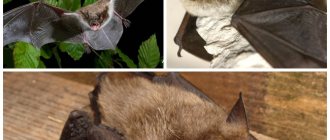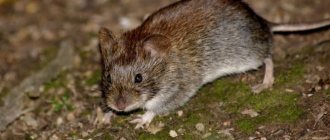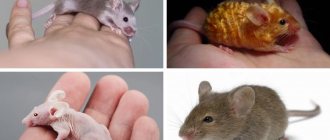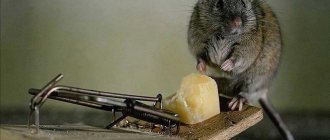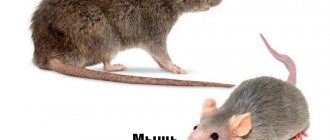People often keep rodents as pets. Fluffy hamsters, decorative mice or guinea pigs delight the eye and delight both children and adults. They live in their beautiful cages and do not leave their confines, they are watered and fed with special food, they play with them and love them.
But there are also rodents that do not bring joy at all, but only cause harm. Wild rats and mice can come into your home like uninvited guests and cause considerable damage. If mice only damage property, then the rat may even attack the person himself. You need to get rid of them immediately and the sooner the better.
What diseases do mice and rats carry?
First of all, these rodents are dangerous because they are carriers of a huge number of infections and diseases; they often do not get sick themselves, but easily transmit the infection to another organism.
They can infect both pets and people. Fleas or ticks that have settled on rats and mice can jump onto cats and dogs. But more terrible diseases can be transmitted to humans.
List of a few of them:
- The most important disease in history that was spread by rats was, of course, the plague.
- Mice can also be carriers of rabies, which is dangerous for both people and animals.
- Wood mice can become carriers of encephalitis, which they, in turn, get from ticks that parasitize them.
- Very dangerous diseases that can be acquired from rodents are leptospirosis and toxocariasis.
- Rats also infect people with fever.
- A person can get giardiasis from rats and mice.
All diseases, if not responded to in time and given proper treatment, can lead to the death of the infected person.
How and where you can become infected with diseases from rodents:
- By direct contact with a rat or mouse, either alive or dead.
- When bitten by a rodent.
- When consuming food or water that comes into contact with these animals.
- In contact with rodent feces and urine, or in food or water.
Why do cats catch and eat mice?
Mice have taurine. These small rodents contain up to five times more of this amino acid than beef, for example. And it just so happens that this is important for the functioning of a cat's body. So, you already know the answer to the question: why do cats eat mice? It is their meat that is the healthiest for them. Without taurine, a cat cannot function normally, and small kittens cannot grow normally and healthy. Its deficiency means the cat is at risk of serious illness and even death...
Perfect food
- In addition to the necessary taurine, the cat receives a properly balanced diet with the help of the mouse. The size of the prey perfectly satisfies the pet's appetite - cats do not eat in reserve, they can only eat as much as their small belly can accommodate. A mouse seems like the perfect food.
- Cats eat the whole mouse carcass, leaving nothing of the small rodent. This way, they also quench their thirst because cats get most of the water their bodies need from their food.
- Mice also get some carbohydrates that have been found in the mouse's digestive tract. Cats don't actually need to consume more carbon than they do inside their prey.
More than just nutrients...
Nowadays, the domestic cat has much more food than running around and catching it for food. Therefore, if your cat complains about food and appetite, use a trick and get her to move. It really works! Let's return to rodents. Why do cats eat mice? In addition to being a well-balanced cat food, their appeal is enhanced by the mouse's tendency to run away. If she didn't do this, who knows if the cats would be equally interested in her?
What else are mice and rats dangerous for humans?
Damage to property
In addition to the fact that rodents pose a risk of infection, they also cause damage to property. Most often they start in their own home rather than in apartments. But there they “work” brilliantly.
First of all, the big problem is that they can destroy an entire harvest and a year's supply of food. They climb into sheds and barns and gnaw through bags of grain and cereals. They eat up supplies of vegetables and fruits.
Mice are also capable of spoiling crops while they are still growing in the beds; they make holes in the beds and spoil everything that grows in them.
In addition to food, rats and mice can also damage residential property . They are capable of chewing through walls and floors, and they can do this both in outbuildings and in residential premises. Mice can chew through furniture, clothes, books, wires and, in general, anything that gets in their way.
On top of that, they leave their excrement everywhere. And the most dangerous rats can attack small animals and birds.
Spoilage of water and food
Also, rodents infected with any infections can transfer their infection to food.
While they gnaw on cereal and grain reserves, they also leave behind all the harmful bacteria that can become pathogens. Plus, at this time they leave dangerous excrement in the bags.
The same applies not only to stocks, but also to products consumed at a given time. There are no barriers for rodents and they can easily climb onto tables or into cabinets and infect all the food and utensils.
A very serious point is that mice and rats can contaminate entire wells with drinking water, because the slightest ingress of this animal, living or dead, makes the water unfit for consumption.
Fire danger
Another serious problem that wild mice and rats pose is the possibility of fire. Mice can chew through anything, and very often their choice falls on the electrical wires that run throughout the house.
Rodents can chew through wiring and cause a short circuit, which in turn can result in a dangerous fire.
Smell
Also, hated rats and mice can, in addition to all other problems, leave unpleasant odors from their presence, which are quite difficult to get rid of. The fact is that rodent excrement contains a large amount of ammonia , which causes the stench.
This smell can be removed, first of all, only by completely getting rid of the rodents. If you don’t get rid of them, they will shit again and again, and in this case the smell will definitely be removed. After getting rid of mice, you need to very carefully check all secluded places and get rid of all excrement.
You should carefully inspect the furniture and soft toys; they may have gnawed nests. You also need to change all the curtains, bedspreads, pillows, etc. And everything that was in the house when mice were in the house and is saturated with their smell must be thoroughly washed.
A good way to eliminate mouse odor is to wipe floors and other surfaces with water with the addition of vinegar, bleach or hydrogen peroxide. You can also use special chemicals that are sold in specialized stores.
In addition to the smell of excrement, the stench can be emitted by the corpses of rats and mice . If the animal was killed by a mousetrap or poison, then its corpse was found and removed. But if the mouse died a natural death in a secluded place, then its body may emit an odor.
If there are only a few corpses, then the smell will not be particularly strong and dangerous, but if there are many of them, then the smell can be saturated with corpse gases and cause poisoning. To remove it, of course, you need to get rid of all the dead rats and mice.
Under no circumstances should you use your hands, sticks, ropes or fishing lines with hooks. Afterwards, do general cleaning using special products and ventilation.
Bats: to eat or not to eat?
By the way, about the culinary component. When we imagine that bats are eaten, most often the average person has the image of a tiny bat in which, like a sparrow, there is nothing to eat. But the order of bats is very diverse and numbers more than 1,300 species. Chiropterans inhabit the entire planet, excluding the Arctic and Antarctica. Just as bats are diverse, so is the cuisine... Of course, large species are eaten as food.
I have long noticed that the passion for eating everything that moves is inherent in countries where in some historical periods there was simply nothing to eat. And then, in the well-fed years, these dishes entered restaurant menus as a delicacy. I hope you don’t think that the French initially began to eat frog legs out of a well-fed life in search of something exclusive. No, they started eating them in search of protein food. Snails and onion soup are from the same times of the Hundred Years War, which, as you know, lasted not a hundred years.
However, let's return to bats. Of course, bats live where it is warm and cozy, and when it is cold, they hibernate, which can last about 6 months. Here you can remember Bram Stoker and his novels about vampires who turn into a bat. But there is no smoke without fire - the Desmodidae family, indeed, feeds by hematophagy - drinks the blood of warm-blooded animals, not disdaining sleeping people.
Chiropterans, primarily bats, have been the object of religious superstitions in Western Europe for a long time. The Catholic Church has traditionally portrayed them as the classic retinue of witches and warlocks.
The bat's furry body resembles that of a rat or mouse. The leathery membranes of the wings are stretched over a frame resembling the spokes of an umbrella, large translucent ears with cartilaginous thickenings and clearly visible blood vessels, a pig-like snout with bristling bristles, a habit of sleeping upside down, claws hooked on the arches of a cave immersed in darkness.
Bat dishes are also known in the southern regions of China. Thus, in Cantonese cuisine, fruit bat meat is considered an exotic dish.
I remain of the opinion that chiropteran meat is simply a cheap alternative to expensive meat, and in second place is culinary traditions and an attraction for tourists.
Mice are also famous for the fact that their droppings, which are scraped off rocks by enthusiasts, are called mummies. They are smeared with it and eaten with milk and honey. Who likes what more...
In addition to culinary exoticism, mice also provide benefits. It turns out that they have amazing immunity, which is adapted to peaceful coexistence with various pathogens. This surprising resistance could form the basis of new research into antiviral drugs for humans, says Paul Webal, a senior lecturer at Kenya's Maasai Mara University.
But how, I wonder, do people manage to catch a bat? Actually, it's not difficult. It is enough to place several people with a fishing net at the exit of the cave in which the animals spend the day and from which, at dusk, thousands leave to feed. A person with a shotgun at this time has every chance of killing 20-30 bats with one shot. Only then will the cook have to remove all the pellets from the carcasses. You can put a net trap. You can catch it on a white duvet cover, where mice are usually stuffed in the Moscow region or in the south of Russia.
Failed to catch? Can buy!
Go to the market in any Asian country, they will sell you a ready-made gutted mouse.
How to cook?
Processing is reduced to the following operations: gutting, trimming the wings and head, singeing. But sometimes they put the whole thing in the soup, without peeling it, along with the skin. For example, in Fiji it is popular for the mouse to be boiled whole instead of with the skin. The dish is expensive, and we don’t understand this added value, but for the locals it is a real delicacy that few people can afford.
Wings are not eaten. Despite the visual volume, there is simply nothing to eat there. The wings have no weight - only light bone and membrane. But I am sure that the locals probably know how to make some kind of soup from them - after all, bones and collagen. They make soup from fins.
It is worth noting that for the average person all these animals are bats, but the large individuals that are most often eaten by residents of Asia, flying foxes, are a genus of bats of the fruit bat family (Pteropus seychellensis). Flying foxes are the largest representatives of bats. There are at least 60 extant species of flying foxes. They live in the tropics and subtropics of South and Southeast Asia, New Guinea, Oceania, Australia and Madagascar. In the Seychelles Islands, in the Indian Ocean, fruit bat (flying fox) meat, seasoned with curry, is one of the national and main dishes of Creole cuisine. The Seychelles flying fox is one of the most commonly eaten bats.
Here is an excellent video demonstrating the processing and preparation of bats in Indonesian cuisine:
If anyone decides to try it, share your impressions!
Poison for mice and rats
At any hint that there are rodents in the house, they must be exterminated immediately. There are many remedies for this, both chemical and folk.
Tsunami
A Russian drug that helps in the fight against rodents. It is produced as food bait, after consumption of which death occurs within 3-10 days. This bait contains food additives that will attract mice to eat it, even if there is another available food source in the house.
Also, the drug is made with such additives as not to create a desire for consumption in pets. The Tsunami mouse repellent is not particularly dangerous to humans and can be used in kindergartens and schools in non-play areas, as well as in hospitals in empty wards.
To combat rodents, it is necessary to place a small amount of bait in places where they have the most food supplies, these can be bags of cereal, trash cans, and water sources.
Ratindane
The drug is also a bait, eating which the rodent ensures 100% death within 7-14 days. It is also safe for other animals and can be used in residential areas.
In order to make bait, there is a specific recipe:
- take 30 g of Ratindana;
- 50 g sugar, 30 g vegetable oil;
- 900 g food base.
Everything is thoroughly mixed, laid out in containers and placed in different places.
Nutcracker
Ready food bait. It is produced in dough-like form and packaged in 10 g bags. The bag should be placed around the perimeter of the area inhabited by rodents at intervals of 2-10 m, depending on the number of harmful animals.
It is better not to touch the bags with your hands, as a human odor may remain on them, which will repel mice. When some bags are eaten, they need to be replaced with new ones, and this should be done until the death of all rodents, which occurs in 3-7 days.
Storm
This poison for mice and rats can be produced in various packages of different volumes, from a small bag to a 10 kg bucket, which allows you to purchase the right amount depending on the size of the territory.
The bait is released in the form of granules with jagged edges. This form specifically provokes even a well-fed mouse to chew the poisoned pellet at least a little.
Rat Death 1
A very effective poison for rodents, it contains food flavorings, which makes it especially attractive to pests.
The disadvantage of this poison is that it is just as toxic to humans, and it must be used in strict compliance with the instructions.
Hunter
Gel for preparing baits for poisoning rodents. It must be mixed into a food base, 1 kg of which will require 50 g of gel. Poisoned baits should be laid out around the perimeter of the territory and, when used, new portions should be added.
Alto
This product is a special glue that is used in the fight against rodents.
To use it, you need to take any substrate; it can be made of cardboard or wood, or any other material that fits the shape. You can take a smaller area for mice, and a larger one for rats.
On this substrate you need to apply glue in an even layer and put some favorite treat for rodents as bait. Once a mouse or rat gets into the glue, it will not be able to get out and will die right on the substrate.
You need to make several baits and place them indoors in places most suitable for frequent habitation of rodents.
Preventive measures
Prevention of rodents
In order to prevent people from becoming infected from mice, preventive measures should be strictly observed:
- try not to come into contact with mice and their secretions;
- burn clothes that were used while working in areas where pests are concentrated;
- do not eat foods with traces of mice and rats;
- store food in well-packed containers;
- observe hygiene measures before eating;
- keep not only the rooms in the house clean, but also all kinds of buildings on the plot;
- carry out comprehensive measures to exterminate mice (deratization), using possible methods;
- do not arrange garbage dumps in places not intended for this purpose;
- control food storage.
It is quite difficult to eradicate the “mouse infection”. In populated areas, deratization should be carried out by local authorities. Otherwise, there is always a risk of contracting diseases carried by mice and rats.
Traditional methods of controlling rodents
Traditional methods of controlling rodents:
- You can prepare a trap consisting of two containers standing next to each other. One of them will contain water, the second will contain flour and gypsum in equal proportions. The implication is that after the mouse gets enough of the flour and drinks water, and the plaster that hardens in the stomach will kill the pest.
- The following bait also has a detrimental effect on the organs of mice: crushed wine cork is mixed with crumbled bread and a small amount of unrefined butter.
- All surfaces in the area where rodents have infested can be treated with substances whose smell they hate. It can be naphthalene, kerosene or turpentine.
- To get rid of rodents in non-residential premises, basements or barns, you can scatter crushed wood ash over the entire floor. It irritates the oral cavity and internal organs of rats, so they will be forced to move to another place.
In order to get rid of such a problem as rodents without a trace, and most importantly, safely, you need to follow all safety measures both when working with various poisons and in relation to your own limitations from any contact with such infectious animals.
Why does a cat catch a mouse but not eat it?
- It turns out that they have more important reasons for this than just a desire to have fun and increase hunting emotions.
- By forcing the mouse to intensely fight for life, the cat affects the production of lactic acid in the mouse's body - just like our muscles during a long run or workout.
- Since this acid has nutritional and palatable qualities for cats, this “tired mouse” is a more valuable food for them. This is cruel for us, but the cat is guided by its instinct. There is no point in saving such prey. The cat had probably already dealt her a fatal blow. What's happening? Is the victim still alive? The cause is a bacterium found in the saliva of most cats. This bacterium is Pasteurella. It causes apasteurellosis in the victim. If the animal is not given the medicine immediately, it will still die within 48 hours, even if it manages to escape from the cat's pursuer.
Cats have been hunting rodents since time immemorial and thus helping people. They protected crops and supplies from intruders. Nature has orchestrated this so perfectly that mice also provide the best balanced meal for their beloved pets, besides allowing them to pursue their hunting aspirations and achieve the satisfaction of a successful hunt.
We should not stop our cat from hunting mice. The only prerequisite is the cat's safety. If we suspect mice are being poisoned in our area, be careful. Our pet can also be poisoned.
If our cat does not have the opportunity to go outside and eat outside, then we must provide her with healthy food rich in taurine and other ingredients necessary for cat health. Let's forget about cheap and popular food from the market. Studies have shown that they not only do not contain taurine, but also enhance its excretion from the body.
See also: why does a cat eat bags?
5 Home Remedies to Get Rid of Mice Naturally
Exception
To enter the home they only need a hole the size of ten kopecks. Careful inspections should be carried out periodically to ensure that there are no entry points (foundations, pipes, wires).
Wire mesh or quick-drying cement can be used to seal cracks around drainpipes and other small entry areas. Foam insulation is used to fill small to medium sized holes.
Sanitation
A clean house will make it harder to find shelter and food. Clean up crumbs immediately and store food and trash in containers protected with tight-fitting lids or in cabinets.
Traps
Early autumn and winter are the times of year when rodents move around. Mice can be humanely trapped and returned to the outdoors. For best results, place them where pest activity is visible.
Lures
Toxic baits work well when there are a lot of pests. Use secure devices that are protected from unauthorized access. Keep them out of the reach of children and pets.
Repellers
Ultrasonic devices keep mice out of the home . They make sounds that are inaudible to humans. Each device protects one room.
House mouse
The house mouse has been domesticated as both a house mouse and a laboratory mouse, which is one of the most important model organisms in biology and medicine. The complete mouse reference genome was sequenced in 2002.
House mice usually live in close proximity to people, in or around houses and fields. Originally native to Asia (northern India), they spread to the eastern Mediterranean around 13,000 BC. Spread to all parts of the globe by people. They were considered the main reason for the domestication of cats.
